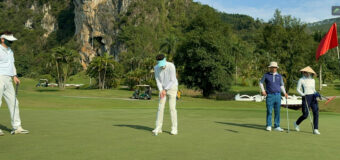Hey there! So I recently came here to the US to meet a very dear friend from college.
As you all know, I am an avid traveller, and exploring new places, as well as old places in new ways, is how I live my life.
Therefore, even though I have visited the US before, I discovered something new here. My friend and her husband took me to a Country club one evening.
There, I saw people in groups playing Pickleball. My friend told me that this particular sport is the new trend here.
I started asking questions. They told me everything: how to play the sport, how to choose the right pickleball paddle, and everything else.
Voila! As an avid traveler and a follower of trends, I was intrigued! Therefore, I decided to look more into Pickleball, a sport that the US gifted me.
How To Choose The Right Pickleball Paddle?
This is the trickiest one, so I decided to make this easier for you.
When picking the right pickleball paddle, consider your skill level, playing style, and physical traits.
Moreover, as a beginner, choose midweight paddles. They offer a good balance of power and control.
If you’re an advanced player, you may prefer lighter or heavier paddles depending on whether you focus more on speed or power.
Be sure to consider the paddle’s weight, grip size, and shape, as these factors will significantly impact your comfort and performance.
1. Setting Performance Benchmarks
Experienced players know that finding the right mix of power, control, spin, and maneuverability is a real challenge.
Furthermore, each match demands a paddle that responds fast during attacks and offers enough touch for precisely placed shots.
Relying on trial and error or flashy marketing often leads to frustration. A well-informed paddle choice, on the other hand, makes it easier to sharpen each part of your game.
Therefore, choosing with purpose transforms the paddle from a basic tool into a reliable asset for every rally.
2. Paddle Anatomy: Core Design Elements
The main parts of a paddle—face material, core structure, and edge guard—combine to give every model a unique feel and shot response.
- Face Material: The surface layer affects both touch and spin. Gritty textures help grab the ball.
This makes it easier to create sharp angles and high spin, while smooth faces offer a more consistent rebound for flat shots.
- Core Structure: Most cores use polymer, aluminum, or Nomex in a honeycomb pattern. Thicker, softer cores absorb shock and soften powerful balls, favoring control. Thinner, firmer cores add speed and punch to returns.
- Edge Guard: The protective band around the paddle helps resist damage but can slightly narrow the playable surface. Some players prefer edgeless designs for wider sweet spots, accepting the trade-off in durability.
Moreover, you can match these design choices to tactical goals to help improve both strengths and consistency.
For example, choose a grippy surface for aggressive topspin or a soft core for gentle dinks at the net.
3. Material Matters For Paddle Dynamics
Materials impact every on-court move. Composite paddles blend fiberglass and resin for reliable power and solid durability.
Additionally, they support quick, forceful drives but offer less finesse on short shots.
Carbon-fiber paddles stand out for their lightweight, extreme strength, and crisp feedback. They provide a fast response and let skilled players flick the ball with both power and touch.
For those ready to upgrade, browsing modern pickleball paddles with carbon-fiber faces can reveal new shot possibilities, especially when testing for spin and reaction.
Furthermore, Wood, while inexpensive, feels heavier and less responsive. It fits beginners but rarely meets the demands of competitive play.
Moreover, in scenarios like fast exchanges or angled volleys, high-quality materials make a noticeable difference in gameplay.
4. Weight And Balance: Fine-Tuning Your Touch
Paddle weight and balance change how a paddle swings and feels. Each distribution offers different advantages.
Weight Distributions:
Handle-Heavy: Extra weight in the grip for outstanding maneuverability. Helps defensive players flip or block shots with ease.
Head-Heavy: More weight toward the paddle’s tip for greater swing momentum and drive power. Suits aggressive baseliners.
Even-Balance: Mass distributed evenly for all-around stability. Supports both quick net reactions and strong groundstrokes.
Common Weight Ranges:
| Play Style | Weight (oz) | Key Benefit |
|---|---|---|
| Offensive | 8.2–9.5 | Power |
| Defensive | 7.0–8.0 | Quick handling |
| Control Focus | 7.5–8.5 | Balance |
Simple drill: Hit a series of volleys and drives using two paddles of different weights. Notice which feels faster during swings and which offers better control during dinks.
5. Grip And Finish: Comfort Meets Control
Grip size affects wrist stability and shot accuracy. Measure from the tip of your ring finger to the middle crease of your palm.
Additionally, a match in measurement and grip diameter ensures comfort and security. Over-sized handles slow wrist flicks; undersized ones cause fatigue and mishits.
Finish Options:
- Perforated: Channels sweat away, keeping hands dry.
- Cushioned: Softens vibration and absorbs shock.
- Tacky: Improves grip even in humid or sweaty conditions.
Demo Checklist for Grip:
- Hold the paddle in play position
- Check finger spacing—no squeezing or hand gaps
- Simulate multiple shot types (drive, dink, volley)
- Test during a few practice points for slipping or rubbing
6. Paddles For Power And Precision
Different play styles demand different paddle traits. Matching the paddle profile to style can improve both power and control.
| Play Style | Core Density | Face Stiffness | Handle Length | Recommended Features |
| Baseline Hitter | Medium–High | Stiff | Standard–Short | Head-heavy, textured surface |
| Net Player | Low–Medium | Flexible | Long | Soft core, tacky grip |
| All-Court Competitor | Balanced | Medium | Standard | Even-balance, composite face |
Baseline hitters benefit from denser cores and stiffer faces for speed and driving shots. Net players do best with soft cores that cushion soft dinks and blocks.
Additionally, all-court players need a well-rounded paddle with a moderate core and face for both punch and reliability.
How To Choose The Right Pickleball Paddle Through Practical Evaluation Steps
The most direct way to compare paddles is to try them on the court. Many clubs, rec centers, and manufacturers offer demo programs or loaners for short trials.
Simple Testing Protocol:
- Warm-up rally to adjust to the paddle’s weight
- Series of power shots—note speed and accuracy
- Drop-and-dink exchange at the net
- Rotate paddles to compare feel and response
Record notes on:
- Sound (“pop” or “thud”)
- Shot feel—smoothness and feedback
- Hand fatigue after extended play
Rather than specs alone, choosing based on first-hand play experience greatly raises satisfaction and performance.
Match Day Ready With Your Chosen Paddle
Well, now that you know how to choose the right pickleball paddle, you have got the rest of the game!
Moreover, a carefully chosen paddle reflects strategic thinking, considering design, construction materials, weight, grip, and play style.
Additionally, instead of guessing, you can use a step-by-step approach to build real confidence.
Furthermore, players show up for matches prepared, using equipment that supports unique strengths and raises overall performance.
Selecting the right paddle means entering each game with a partner that feels natural in hand, ready for every shot and every point.
Read Also:














